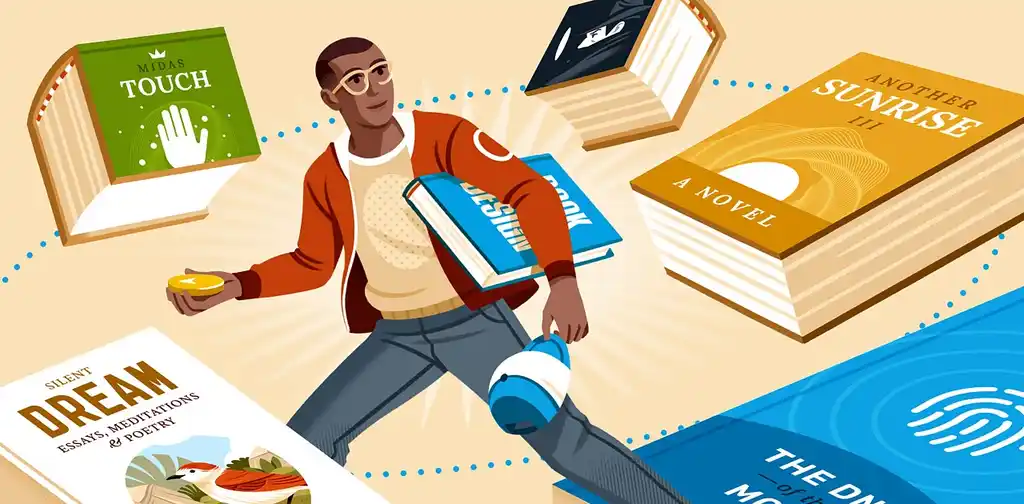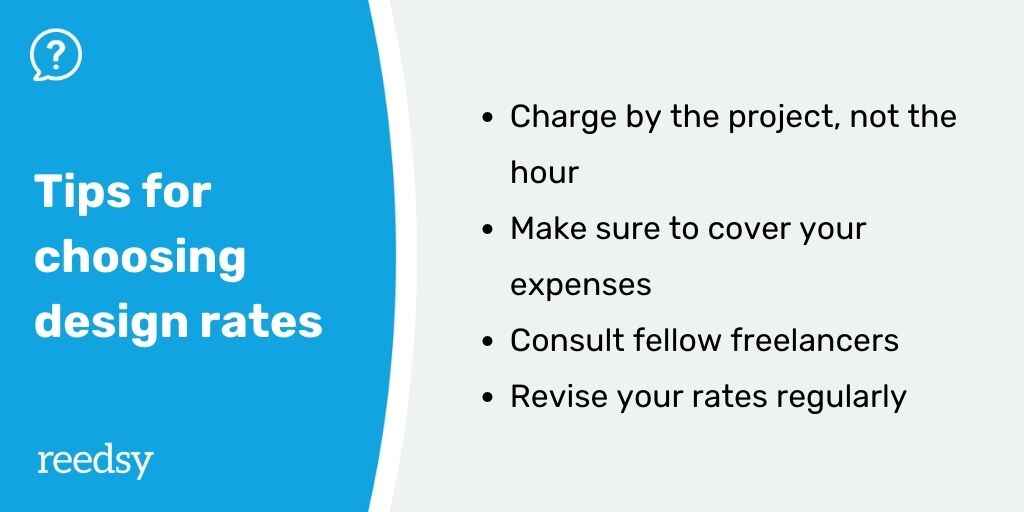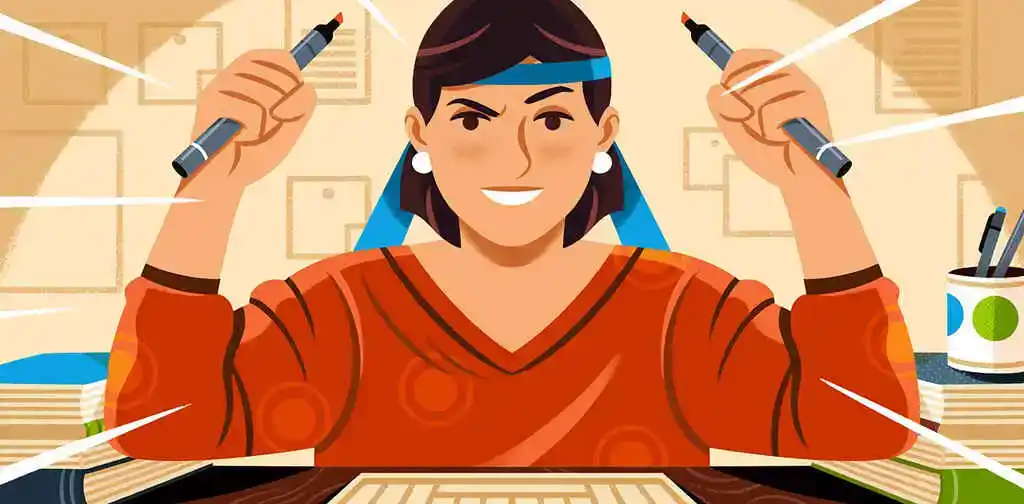Blog •
Last updated on Feb 12, 2025
4 Pro Tips for Choosing Your Freelance Designer Rates
About the author
Reedsy's editorial team is a diverse group of industry experts devoted to helping authors write and publish beautiful books.
More about the Reedsy Editorial Team →Whether you design logos, graphics, book covers, or websites, knowing how to price your services is a big part of having a freelance design business. But in such a saturated market, it’s not always easy to decide — how do you balance being competitive with making a sustainable living? With the help of some of Reedsy’s experienced designers, we’ll give you some tips on how to choose your freelance designer rates.
Average freelance designer rates
To give you a general idea of where to start, here are some average rates charged for design.
Hourly rates
A freelance designer can expect to get paid between $20 and $150 per hour, depending on type of design work and the designer’s experience. However, while hourly rates are often used as an indication of wages in general, designers don’t usually use them in their quotes as each project comes with its own complexities and clients are more interested in the end product than the process of getting there. You’ll therefore more likely find designers who charge a total fee for each project.
Per project rates
Most designers will come up with a rate to charge per project after considering a brief, or discussing the client’s requirements for the project. Below are some common types of design projects and the average rates freelance designers set for them.
Books
According to data from Reedsy’s marketplace, these are the average rates professionals charge for various aspects of book design:
- Book cover: $950
- Interior Design: $800
- Book Cover + Interior Design: $1,500
These rates can vary depending on the book’s genre, the designer’s experience in said genre, and the book’s format (print book or ebook). There are also other variables within each discipline. For example, book cover designers can also ask for a higher price when highly specialized skills, like illustration, are required. Interior book design, meanwhile, will be affected by the length of the book.

JOIN REEDSY
Find exciting new projects
We connect publishing professionals with our community of 1,500,000 authors.
Business cards, logos, infographics, etc.
For business materials like cards, logo design, and infographics, each project can fall in the $100-$2,000 range, depending again on designer experience, as well as on the company’s budget, the industry it’s in, and the requirements it has for the project.
Web design
Another popular kind of freelance design is web design — and it comes with the highest per project rates, often between $1,400 and $5,000. Some projects may involve building a new website from scratch, while others involve redesign an existing website. We will talk more about what factors may go into the rates for this kind of project in the next section.
Tips for setting your rates as a freelance designer
 While the averages can give you a guideline to orientate yourself, you should work on a pricing strategy that really works for you, given your service, niche, and skills. Here are some of the tips that Reedsy’s professional designers have shared with us.
While the averages can give you a guideline to orientate yourself, you should work on a pricing strategy that really works for you, given your service, niche, and skills. Here are some of the tips that Reedsy’s professional designers have shared with us.
1. Charge by the project
For most projects, it is much more worthwhile to charge per project. Think about what you are providing your client, and what the value of that is, rather than evaluating your work with a clock. Not only does charging an hourly rate require meticulous time tracking, it also doesn’t account for your skills. More skilled designers are more likely to finish a project faster — but that does not mean they should be paid less.
Q: How many rounds of revisions do you include in your initial offer?
Suggested answer
For book cover designs, I typically provide unlimited revisions. I view each project on Reedsy as a genuine collaboration, with everyone working toward a shared goal.
So far, this approach hasn’t been abused. Rather, it assures authors that I’m committed to refining the cover design until they are completely satisfied with the outcome.
Jonathan is available to hire on Reedsy ⏺
Moreover, an hourly rate fails to consider the unique requirements and conditions of each project. Book cover designer Jeff Brown talked about this with us in a recent webinar: “For me, some of the covers will take way less time than others. That's kind of the luck of the draw. It doesn’t affect the pricing — I personally charge the same thing for book covers. The pricing is really irrelevant to me when it comes to how much time I put into a piece; it's the final product that matters.”
Interior book designer Vanessa Mendozzi says that, when typesetting books, she factors the final word count, the number of images/tables/graphs, and the number of footnotes/endnotes into her project’s quote.
Meanwhile, web designer Jessica Skorich considers the following when coming up with her quote:
- Expected deadline;
- The size of the site (number of pages, content, etc.);
- Functionality requests (is it an ecommerce site? Does the client want a mailing list?);
- Platform (some platforms are more limited to build on, e.g. Wordpress);
- Social media (buttons from website, banners, etc.); and
- Content requirements (SEO, illustrations, etc.).
Regardless of what kind of design you do, as long as you base your freelance designer rate on the value of your work, then you’re off to a good start!
2. Take your expenses into account
Another important factor when it comes to setting rates is to think about what you want to earn. In any case, you should be able to cover your own expenses and maintain your life.
In an official, tax-based sense, expenses include anything you have invested in which allows you to do your job, like your computer, design software, or stock imagery. But as a freelancer you also have to take care of setting up an office, paying utility bills, hiring an accountant, etc.
Given a full work schedule, i.e. assuming you consistently get new projects, you should have enough to cover all of those expenses and some extra for yourself. Thinking about this not only helps you establish a sustainable rate, you also are on top of your own financial situation. Once you’ve calculated your “overheads” in this way, you’ll have a good pricing floor to work up from.

FREE RESOURCE
Invoice Template
Provide billing and payment details with this professional template.
3. Reach out to fellow freelancers
The averages we provided above are exactly that — averages. They don’t reflect differences in level of experience, or in specialties and niches. To really fine-tune it and find the suitable rates for your business, you might want to reach out to other designers who work in the same field as you, and see how they manage their prices. Freelancer communities are usually friendly and willing to help, so don’t be afraid to ask!
Reddit, for instance, hosts an active community of designers and artists on its platform — including subreddits like r/Design (which comes with a Discord group, too) and r/graphic_design. The nice thing about these big communities is that you can get thoughts from multiple designers with different experiences and perspectives, and you can decide what kind of pricing strategy might work best for you.
4. Revise your rates regularly
The final tip is to revise your rates every year or so. Your skills develop all the time, so naturally, your work should be of greater worth, and that will be reflected in what you charge. Keeping the same rate for years will probably lead to you undercharging, not least because of inflation.
Q: How often do you revise your rates, and what triggers the need for a change?
Suggested answer
I usually review my rates yearly, after closing the previous tax year. I keep track of timing on projects so I can see which ones ran over the original fee and whether adjustments are needed.
Inflation and rising costs are an obvious factor, but I also consider changes in the scope or complexity of work I’m doing, feedback from clients about the value I provide, and shifts in the market that affect what other designers are charging.
Occasionally, if I develop new skills or start offering additional services, that can also trigger a rate review.
This approach helps me ensure my rates remain fair, sustainable, and reflective of the time, expertise, and creativity each project requires.
Clare is available to hire on Reedsy ⏺
I review my rates from time to time to make sure they reflect the work involved. Things that can trigger a change include more complex projects, extra time needed for revisions, or the cost of tools and assets I use to create the covers. I try to keep my pricing fair and transparent, so authors know they’re paying for quality work while I can continue delivering polished, professional designs.
Alexandra is available to hire on Reedsy ⏺
I review my rates every year. Generally, because of inflation and also as my skill level increases.
Tommy is available to hire on Reedsy ⏺
With more experience in freelancing, you’ll also discover other aspects of the job that should be factored into your pricing. For instance, designer Vanessa Mendozzi reflected: “Looking back, sometimes I wish I had charged more for some projects. I would tell my younger self to also consider the ‘back and forth of emails and messages’ when sending a quote to a client. Because time is money and it's not all about the actual graphic design work.”
So as you grow, remember to bump your rates up. Customers who really want your expertise and skills will be willing to pay the price that you ask.
We hope the tips and averages above can be of use to you when you set your freelance designer rates. Think of the value of your designs, and don’t be afraid to send a quote that’s an accurate reflection of your hard work — you’re worth it!
Q: How do you keep up with industry trends?
Suggested answer
I keep up with industry trends in a few different ways. I regularly research bookshops, both online and in person, to see what is happening on the shelves right now and how design is shifting across genres. Social media is also useful, especially Instagram and Pinterest, which are full of designers, illustrators and publishers sharing new work and fresh ideas.
I also follow design blogs, agencies and publishers, and I keep an eye on what is being shortlisted for design awards. Often, those projects are the ones pushing boundaries and setting the direction for what comes next.
That said, I do not believe in following trends for the sake of it. For me it is about being aware of the landscape, so that I can make informed choices: when to align with current styles, and when to deliberately do something different so a book stands out.
And honestly, nothing beats wandering around a bookshop, picking up the latest releases and seeing what catches your eye. It is my guilty pleasure and my favourite research lab all in one!
Clare is available to hire on Reedsy ⏺
I stay on top of industry trends in several ways, but being an avid reader helps the most. The majority of the genres I specialize in are the ones I read myself, so I naturally absorb what works for readers — from themes and tone to popular visual cues.
I also keep an eye on bestselling covers, explore new tools and techniques, and follow other designers and illustrators for inspiration. Combining this ongoing research with my own reading experience helps me create covers that feel current, professional, and true to the story.
Alexandra is available to hire on Reedsy ⏺
Always looking for what is out there, on new book's releases. Reading about trends not just on books but in design, fashion, and color trends. Social media is also one of the best ways to keep up with the new trends.
I like to interact with younger professionals and keep a GLOBAL MINDSET when looking around.
Veronica is available to hire on Reedsy ⏺
Reviewed by Linnea Gradin
The editor-in-chief of the Reedsy Freelancer blog, Linnea is a writer and marketer with a degree from the University of Cambridge. Her focus is to provide aspiring editors and book designers with the resources to further their careers.
As the editor of Reedsy’s freelancer blog and a writer on the Reedsy team, Linnea has her hand in a bit of everything, from writing about writing, publishing, and self-publishing, to curating expert content for freelancing professionals. Working together with some of the top talent in the industry, she organizes insightful webinars, and develops resources to make publishing more accessible to writers and (aspiring) publishing professionals alike. When she’s not reading, she can be found dribbling on the football pitch, dabbling in foreign languages, or exploring the local cuisine of whatever country she happens to be in at the time.
